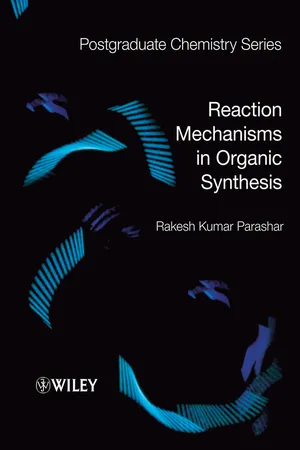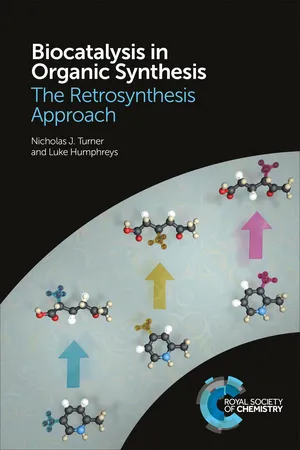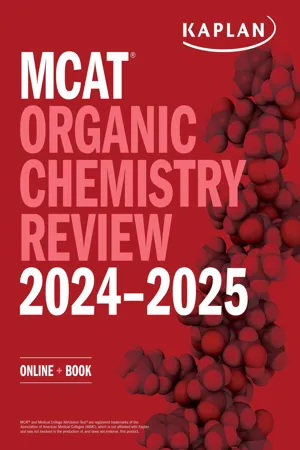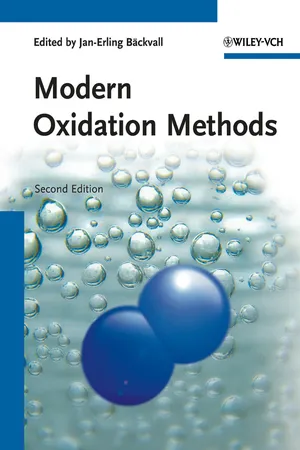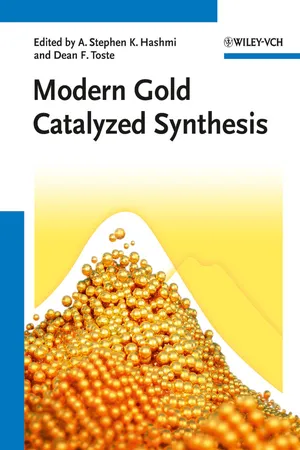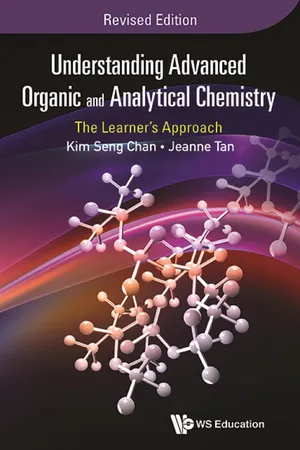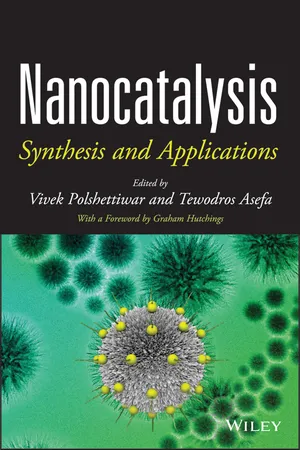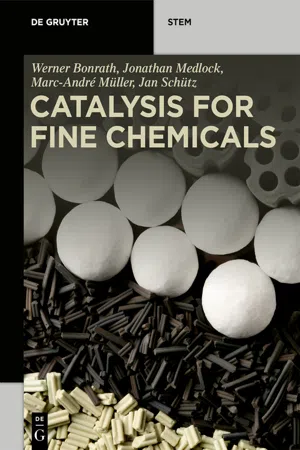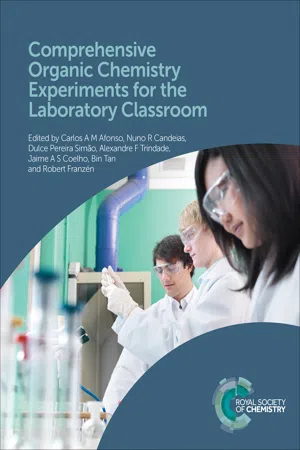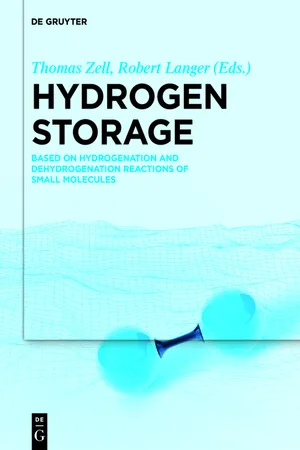Chemistry
Oxidation of Alcohols
Oxidation of alcohols refers to the chemical reaction in which alcohols are converted into carbonyl compounds, such as aldehydes or ketones, through the loss of hydrogen atoms. This process typically involves the use of oxidizing agents, such as potassium permanganate or chromium(VI) reagents. The oxidation of alcohols is an important transformation in organic synthesis and plays a key role in the production of various chemicals and pharmaceuticals.
Written by Perlego with AI-assistance
Related key terms
Related key terms
1 of 4
Related key terms
1 of 3
11 Key excerpts on "Oxidation of Alcohols"
- eBook - ePub
- Rakesh Kumar Parashar(Author)
- 2013(Publication Date)
- Wiley-Blackwell(Publisher)
Chapter 7
Oxidation
7.1 Oxidation of Alcohols
Oxidation of Alcohols to aldehydes or ketones is one of the most useful transformations in organic chemistry. Simple 1°- and 2°-alcohols in the gaseous state lose hydrogen (dehydrogenation reaction) when exposed to a hot copper surface. However, in solution phase alcohol oxidations are carried out using reactions in which the hydroxyl hydrogen is replaced by an atom or group that is readily eliminated together with the α-hydrogen. The decomposition of 1°- and 2°-alkyl hypochlorites is an example of such a reaction.In a similar manner, toluene-p -sulfonate derivative of alcohols on nucleophilic displacement with trimethylamine N -oxide followed by treatment with a base gives the carbonyl compound and trimethylamine.7.1.1 Chromium(VI)
The most common reagent for the oxidation of 1°- and 2°-alcohols is chromic acid (H2 CrO4 ). It is difficult to stop the reaction at the aldehyde stage; thus, primary alcohols are oxidized to carboxylic acids. In some cases, good yield of an aldehyde can be obtained by removing the aldehyde from the reaction mixture.However, the secondary alcohols give ketones.In aqueous medium, chromium trioxide (CrO3 ) exists in equilibrium with several Cr(VI) species such as H2 CrO4 , Cr2 O7 2– , H2 Cr2 O7 , H2 Cr2 O7 − , CrO4 2− and HCrO4 − . The dominant form of Cr(VI) species formed in the aqueous solution depends on the pH value, solvent and concentration. At high dilution, dichromate anion (Cr2 O7 2− ) is the major species.At high concentration, (CrO3 )n and chromic acid (H2 CrO4 ) are the main species. As alcohol is oxidized to carbonyl compound, Cr(VI) is reduced to Cr(III). However, the detail mechanism shows that Cr(V) and Cr(IV) species are also involved in the Oxidation of Alcohols. The Cr(VI) species are usually HCrO4 − and CrO3 and the Cr(IV) is usually HCrO3 − - eBook - ePub
Biocatalysis in Organic Synthesis
The Retrosynthesis Approach
- Nicholas J Turner, Luke Humphreys(Authors)
- 2018(Publication Date)
- Royal Society of Chemistry(Publisher)
Figure 6.26 .Figure 6.26 Selected methods for the chemical Oxidation of Alcohols to ketones.Despite many useful synthetic methods, the Oxidation of Alcohols often uses metal catalysts that need to be disposed of at the end of the reaction or conditions that may be unsuitable for more sensitive functional groups. This in turn may require the use of protecting groups, which adds extra steps to a synthesis. It can also be difficult to stop the oxidation at one level above the alcohol, with over-oxidation to give carboxylic acids or esters often observed. As a complementary technology, the Oxidation of Alcohols using enzymes offers the advantage of mild reaction conditions and high selectivity. This could be regioselective oxidation of a polyol substrate or selective oxidation of one enantiomer of a racemate. Each of the following sections details a family of enzymes that is capable of oxidising alcohols to aldehydes and ketones.6.4.1 Oxidation of Alcohols Using Ketoreductases
As we saw in Chapter 5, ketoreductase enzymes are typically used to catalyse the reduction of ketones and aldehydes to the corresponding alcohols. We mentioned in Chapter 5 that these enzymes are also capable of catalysing the reverse process, the oxidation of an alcohol to the ketone or aldehyde. Due to this reactivity, these enzymes are also known as alcohol dehydrogenases (ADHs). These are the same enzymes and the names are used somewhat interchangeably, so remember that when you see ADH, it is the same as Kred and vice versa . The use of ketoreductases for the Oxidation of Alcohols has been less studied than the reduction of ketones, in part due to the fact that the oxidation of secondary alcohols removes a chiral centre rather than creating one in the reduction direction. As the ADH name suggests, the Oxidation of Alcohols using Kreds is a dehydrogenation reaction with the nicotinamide co-factor this time acting as a hydride acceptor rather than a hydride donor. As shown in Figure 6.27 - No longer available |Learn more
MCAT Organic Chemistry Review 2024-2025
Online + Book
- (Author)
- 2023(Publication Date)
- Kaplan Test Prep(Publisher)
Alcohols are a particular favorite of the MCAT test makers. We got our first look at the unique properties that stem from hydrogen bonding, an important ability of alcohols. Alcohols can be oxidized to aldehydes, ketones, or carboxylic acids depending on the substitution of the alcohol and the strength of the oxidizing agent. From this point forward, oxidation and reduction will be important reactions with all functional groups. Alcohols can also participate in nucleophilic substitution reactions, which may be facilitated by converting the alcohol into a mesylate or tosylate. Finally, phenols (and their oxidized counterparts, quinones and hydroxyquinones) are involved in a number of biochemical pathways. In particular, their utility is seen in processes that require rapid oxidation and reduction, such as photosynthesis and the electron transport chain.Over the next four chapters, we’ll explore other oxygen-containing compounds. Recognize that these chapters are put in a specific order: as you move further along in MCAT Organic Chemistry Review, the functional groups will become more oxidized and more reactive. First, we’ll look at aldehydes and ketones (and their deprotonated forms, enols and enolates). Then, we’ll explore carboxylic acids and their derivatives: amides, esters, and anhydrides.GO ONLINE!
You've reviewed the content, now test your knowledge and critical thinking skills by completing a test-like passage set in your online resources!CONCEPT SUMMARY
Description and Properties
- Alcohols have the general form ROH and are named with the suffix – ol. If they are not the highest priority, they are given the prefix hydroxy–.
- Phenols are benzene rings with hydroxyl groups. They are named for the relative positions of the hydroxyl groups: ortho– (adjacent carbons), meta– (separated by one carbon), or para– (on opposite sides of the ring).
- Alcohols can hydrogen bond, raising their boiling and melting points relative to corresponding alkanes. Hydrogen bonding also increases the solubility of alcohols.
- eBook - ePub
- Jan-Erling Bäckvall(Author)
- 2011(Publication Date)
- Wiley-VCH(Publisher)
10 Oxidation of Carbonyl Compounds Eric V.Johnston andJan-E. Bäckvall 10.1 IntroductionOxidation of carbonyl compounds is an important area of oxidation and involves a variety of different reaction types. This area has been reviewed by Bolm in Chapter 9 of the book ‘Modern Oxidation Methods’ (2004), and the present chapter is an update of this review. We have focused on two areas of carbonyl oxidation where important developments have occurred: (i) oxidation of aldehydes to carboxylic acids and (ii) Baeyer-Villiger oxidation.10.2 Oxidation of Aldehydes to Carboxylic AcidsThe transformation of aldehydes to carboxylic acids is a fundamental reaction in organic synthesis. Many successful methods have been developed for these types of oxidations [1], but most of them have limitations as they require stoichiometric amounts of oxidants such as chlorite [2], chromium(VI) reagents [3], potassium permanganate [4], or peroxides [5]. The use of organic solvents e.g., acetonitrile, dichloromethane, cyclohexane, formic acid, or benzene is also usually necessary. Despite the fact that these methods have several disadvantages, such as low selectivity and production of waste, some of them have been widely used in industry and are still in use today. The growing awareness of the environment has created a demand for efficient oxidation processes with environmentally friendly oxidants under mild conditions (‘green’ chemistry) [6].Molecular oxygen and hydrogen peroxide are desirable oxidants for these transformations, since they are inexpensive and environmentally friendly, with water as the only by-product. Therefore, various improved methodologies using molecular oxygen or hydrogen peroxide directly as the oxidants have been explored in recent years and reported in the literature. - eBook - ePub
- A. Stephen K. Hashmi, F. Dean Toste(Authors)
- 2012(Publication Date)
- Wiley-VCH(Publisher)
Chapter 14 Oxidation of Alcohols and Carbohydrates Cristina Della Pina, Ermelinda Falletta, and Michele Rossi14.1 Introduction
One of the most exciting and unforeseen developments in chemical research in recent decades has been the application of gold in catalysis. In fact, this metal has become an important tool in organic synthesis several years after the first reports on ethyne hydrochlorination and CO oxidation and it is now widely employed in many fundamental catalytic processes such as oxidation, hydrogenation, and coupling reactions [1–4]. New applications of gold have also been proposed for commercial syntheses by academic and industrial researchers [5–8]. An ultimate project concerns an inorganic reaction, that is, the direct synthesis of hydrogen peroxide, which has been developed by the impressive work of Hutchings' group [1–3].A strategic application of gold is the selective transformation of renewable biological resources, a task of key importance for balancing the CO2 cycle. In particular, valuable oxygenated compounds can be produced as new building blocks for further transformations.Although the selective oxidation of organic molecules by gold has been reviewed fairly recently [1–3], the continuing rapid progress makes an update of the state-of-the-art very desirable.Among the various challenging topics, the catalytic conversion of carbohydrates and alcohols to the corresponding carbonylic or carboxylic compounds still remains an powerful aim, as the products are employed as chemical intermediates and high-value components in, for example, the perfumery, food, and pharmaceutical industries [1–8]. Pressing environmental restrictions are pushing research towards the progressive shutdown of traditional methods, such as the use of heavy metal salts as oxidants, because of environmental problems related to the disposal of undesired and toxic by-products. In contrast, selective oxidations using the eco-friendly air or pure dioxygen as the oxidant, and supported metals as catalysts, are attracting general support. Gold catalysis has enjoyed important progress owing to the rapid advances in nanotechnology and nanoscience, resulting in new applications for commercial syntheses in both the academic and industrial research worlds [9–12]. The strong scientific appeal of gold can be easily understood considering its peculiar property to discriminate inside chemical groups and geometric positions [13–15], and its chemical stability, strictly related to the unique features of gold itself. First, the high electrode potential (E ° = +1.69 V), responsible for the well-known inertness of this metal, leads to the sought-after characteristics required in catalysis: resistance to oxygen and tolerance to chemical groups such as aliphatic and aromatic amines, which normally produce poisoning phenomena with other metals. Second, the kinetic aspects of gold catalysis reveal how the activity is highly dependent on the size of metallic gold particles. In particular, many investigations on the liquid-phase oxidation of polyols, alcohols, and carbohydrates indicate that only small gold particles are catalytically active [16, 17], this behavior being common to gold particles employed in the gas-phase oxidation of carbon monoxide [1]. An ultimate catalyst with a stable structure that is active without any support has recently been reported [18–23]: it consists of nanoporous Au, prepared by the dealloying of Au–Ag alloys, by leaching Ag from an Au–Ag alloy through a route similar to that for the preparation of Raney nickel. Gold in such a form is able to catalyze the selective oxidative coupling of methanol to methyl formate with selectivities above 97% and a high turnover frequency (TOF) at temperatures below 80 °C. As the overall catalytic characteristics of nanoporous Au are in agreement with studies on Au single crystals, Friend and co-workers [18] deduced that the selective surface chemistry of gold is unaltered but that O2 can be readily activated with this material. Surprisingly, gold not being in contact with an oxide support, nanoporous Au shows great activity for low-temperature CO oxidation with O2 as an oxidant at atmospheric pressure [20]. It is also active for the liquid-phase oxidation of glucose [21], electrochemical oxidation of methanol [22], and O2 - eBook - ePub
Understanding Advanced Organic and Analytical Chemistry
The Learner's ApproachRevised Edition
- Kim Seng Chan, Jeanne Tan;;;(Authors)
- 2016(Publication Date)
- WS EDUCATION(Publisher)
α-carbon atom is the carbon atom directly bonded to the –OH group.Q:Why can’t the tertiary alcohol be oxidized?A:It has to do with the mechanism of how an alcohol is oxidized. In the oxidation process of an alcohol, a chromate ester intermediate (C−O−CrO3 H) is formed if acidified K2 Cr2 O7 is used. Subsequent reaction involves the extraction of an acidic α-H by a H2 O molecule which is acting as a base. There is no α-H present in a tertiary alcohol, hence it can’t be oxidized through such a mechanism.The type of oxidation products obtainable depends on the type of alcohol and the strength of the oxidizing agent. Common oxidizing agents are potassium manganate(VII) and potassium dichro-mate(VI); the latter is a weaker oxidizing agent as compared to potassium manganate(VII). The following standard reduction potential values explain why:Primary alcohols are readily oxidized to aldehydes which, in turn, are easily oxidized to carboxylic acids.Hence, if the desired product is the aldehyde, the milder oxidizing agent K2 Cr2 O7 should be used, and the aldehyde would be immediately distilled off from the reaction vessel to prevent it from being further oxidized. It is also important to note that the oxidizing agent is being added dropwise into the alcohol. This way of addition is to ensure that the added oxidizing agent is limiting with respect to the alcohol and it is immediately being consumed once it comes in contact with the alcohol. There would not be any excess oxidizing agent present to further oxidize the aldehyde that is formed into carboxylic acid. The set-up for the oxidation is shown below:Q:When we apply immediate distillation during the oxidation process, wouldn’t this cause the alcohol to be distilled out too?A: - eBook - ePub
Nanocatalysis
Synthesis and Applications
- Vivek Polshettiwar, Tewodros Asefa, Vivek Polshettiwar, Tewodros Asefa(Authors)
- 2013(Publication Date)
- Wiley(Publisher)
9 Oxidation of Alcohols USING NANOCATALYSTS Takato Mitsudome and Kiyotomi Kaneda INTRODUCTION Oxidation of Alcohols is widely recognized as a fundamental and important transformation in both laboratory and industrial chemistry, because the obtained carbonyl compounds serve as versatile solvents, polymer precursors, fragrances, and intermediates for fine chemicals such as pharmaceuticals. 1–5 Heavy metal salts, including permanganate and dichromate, have traditionally been employed as oxidizing reagents to achieve this transformation. 6,7,8 These stoichiometric oxidants, however, have serious drawbacks; they are expensive and/or toxic and produce large amounts of waste. From the standpoint of atom economy and environmental demand for chemical reactions, much attention has been directed toward the development of promising heterogeneous catalysts employing molecular oxygen (O 2) as a primary oxidant. 9–14 In this oxidation system, use of harmful oxidants can be avoided and only water is produced as the sole coproduct. Moreover, heterogeneous catalysts are readily available and reusable. The aim of this review is to provide an overview of the heterogeneous catalysts that have been developed for the aerobic Oxidation of Alcohols. Since several reviews and many reports on heterogeneous catalysts for the aerobic Oxidation of Alcohols have appeared to date, 15–18 we focus on the recently advanced and highly efficient heterogeneous catalysts using inorganic material- or polymer-supported active metals of Ru, Pd, and Au for alcohol oxidation under liquid-phase conditions (developments in the past 10 years) - eBook - ePub
- Ning Jiao, Shannon S. Stahl, Ning Jiao, Shannon S. Stahl(Authors)
- 2019(Publication Date)
- Wiley(Publisher)
In fact, oxidation of aldehydes poses a highly challenging task for chemists. Kinetically, the interaction between electrophilic aldehyde and also‐electrophilic oxidant is difficult (Figure 5.1, left). Furthermore, the well‐established single electron transfer (SET) mechanism for alcohol oxidations [ 3 ] is impractical for aldehydes, as the sp 2 ‐hybridized radical‐cation intermediate generated from aldehyde is much more unstable than the sp 3 ‐intermediate from alcohol (Figure 5.1, right). Figure 5.1 Challenges for aldehyde oxidation. Historically, the most important aldehyde oxidation methods use Fehling’s [ 4 ] or Tollens’ oxidation [ 5 ]. Using metallic oxidants such as Cu(II) or Ag(I), remarkably efficient aldehyde oxidation can readily be achieved in a very short reaction time. Both reactions use water as the sole solvent and are performed under mild reaction temperatures (a warm water bath). Almost every type of aldehyde (aromatic, aliphatic, unsaturated, and even aldoses such as glucose and fructose) are efficiently oxidized into the corresponding carboxylic acid (aldonic acid). Such versatility has made Fehling’s and Tollens’ oxidation among the most important aldehyde oxidation methods in history, especially for aldehyde titration‐analysis and the production of aldonic acid, which are extremely difficult to achieve using other methods (Figure 5.2). The mechanism for those reactions is still controversial, even today [ 6 ]. One hypothesis suggests that the aldehyde was first hydrated into the corresponding gem‐diol and deprotonated in basic aqueous solution; then the Ag(I)/Cu(II) coordinated to the deprotonated gem‐diol and extract one electron via SET, generating the gem‐diol radical, which was further extracted one electron to give the carboxylic acid. Another hypothesis involves the formation of Ag(I)/Cu(II)–OH intermediate. The aldehyde was activated by the metal followed by the –OH nucleophilic attack on the activated carbonyl - eBook - ePub
- Werner Bonrath, Jonathan Medlock, Marc-André Müller, Jan Schütz(Authors)
- 2021(Publication Date)
- De Gruyter(Publisher)
The dehydrogenation of alcohols (the opposite of the hydrogenation of carbonyl compounds (see Chapter 2 Heterogeneous hydrogenations and Chapter 3: Homogeneous hydrogenations)) is a clean reaction, and is mainly endothermic, 84 kJ/mol. The reaction itself is usually catalysed by Cu- or Zn-based catalysts, such as ZnO, CuO, Cu–Cr 2 O 3 and follows first-order reaction kinetics. Typical examples from the bulk chemical industry are the manufacture of formaldehyde from methanol in presence of a Fe 2 O 3 –MO 3 catalyst with conversion of 95–99% and selectivity of 91–94%, ethanal (Cu–Cr 2 O 3, X = 30–50%, S = 90%), acetone, 2-butanone (700 kt/a, ZnO or Cu-based catalysts, S = 90%, X = 98%) or cyclohexanone (ZnO or Cu–Cr 2 O 3, 400–450 °C, X = 90%, S = 95%) from their corresponding alcohols [ 2 – 5 ]. The selective oxidation of primary alcohols to the corresponding aldehydes is a challenge for the fine chemical industry. Further aldehyde oxidation to the carboxylic acid or CO 2 should be avoided. This can be achieved by the use of new catalysts and/or modified reactor concepts and oxidation conditions. From an industrial point of view, the citral synthesis via oxidation is an interesting example which fulfils all criteria of modern catalysis. Starting from formaldehyde and isobutene, isoprenol is manufactured by a Prins reaction (Scheme 4.1) (see Chapter 8: Acid–base-catalysed reactions). The oxidation of isoprenol to isoprenal is carried out with oxygen with a very low residence time (10 −3 s). The continuous reaction is performed at >320 °C in the gas phase in presence of an Ag/SiO 2 catalyst under isothermal conditions - Carlos A M Afonso, Nuno R Candeias, Dulce Pereira Simão, Alexandre F Trindade, Jaime A S Coelho, Bin Tan, Robert Franzén, Carlos A M Afonso, Nuno R Candeias, Dulce Pereira Simão, Alexandre F Trindade, Jaime A S Coelho, Bin Tan, Robert Franzén(Authors)
- 2020(Publication Date)
- Royal Society of Chemistry(Publisher)
12. Oxidations 12.1. Ketone and Aldehyde Formation12.1.1. Aerobic Alcohol Oxidation Using a Cu(I )/TEMPO Catalyst SystemNicholas J. Hilla , Jessica M. Hoovera and Shannon S. Stahlaa Department of ChemistryUniversity of Wisconsin-Madison1101 University AvenueMadisonWI53706USA[email protected]Number of sessions (duration of each session) Hazard level Difficulty level Level of study 1 (3 h) Moderate Low Intermediate Class names Benzyl alcohols, aldehydes Concepts involved This experiment gives a “green” oxidation method using a CuBr/TEMPO catalyst system and ambient air as the terminal oxidant to convert 4-nitrobenzyl alcohol into the corresponding aldehyde Chemicals needed 4-Nitrobenzyl alcohol, copper(I ) bromide, TEMPO ( 2,2,6,6-tetramethylpiperidine-1-oxyl), N -methylimidazole (NMI), 2,2′-bipyridine, acetone, anhydrous magnesium sulfate, pentane, deuterochloroform Equipment and experimental techniques involved Apparatus for magnetic stirring, liquid–liquid extraction apparatus, hot plate or rotary evaporator Keywords Extraction, green chemistry, NMR, oxidation, transition metal catalysis Background
Conversions of alcohols into aldehydes and ketones are among the most important and widely used oxidation reactions in organic chemistry. Modern undergraduate organic chemistry textbooks typically present several methods to effect these reactions, and among the most commonly featured oxidants are CrIV and MnIV reagents, such as pyridinium chlorochromate, pyridinium dichromate, CrO3 /H2 SO4 (Jones reagent), KMnO4 , and MnO2 .1- eBook - ePub
Hydrogen Storage
Based on Hydrogenation and Dehydrogenation Reactions of Small Molecules
- Thomas Zell, Robert Langer, Thomas Zell, Robert Langer(Authors)
- 2019(Publication Date)
- De Gruyter(Publisher)
Andrés Suárez6Hydrogenation of carbonyl compounds of relevance to hydrogen storage in alcohols
This article has previously been published in the journal Physical Sciences Reviews. Please cite as: Suárez, A. Hydrogenation of carbonyl compounds of relevance to hydrogen storage in alcohols. Physical Sciences Reviews [Online] 2018, 3 (5). DOI: 10.1515/psr-2017-0028Abstract: Alcohols are a promising source for the sustainable production of hydrogen that may also serve as rechargeable liquid organic hydrogen carriers (LOHCs). Metal-catalyzed acceptorless dehydrogenation of alcohols produces carbonyl derivatives as H2 -depleted by-products, which by means of a hydrogenation reaction can be reconverted to the initial alcohols. Hence, reversible H2 -storage systems based on pairs of secondary alcohols/ketones and primary alcohols/carboxylic acid derivatives may be envisaged. In this contribution, the hydrogenation of carbonyl derivatives, including ketones, esters, amides and carboxylic acids, is reviewed from the perspective of the hydrogen storage in alcohols.Keywords: hydrogen storage, homogeneous catalysis, hydrogenation, carbonyl compounds, dehydrogenation6.1Introduction
The search for solutions to the issue of hydrogen storage is a pivotal aspect for the full implementation of a global economy based on hydrogen as an energy carrier, the so-called Hydrogen Economy [1 ]. In this respect, the incorporation of hydrogen into small organic molecules through the formation of covalent bonds has been proposed as a potential method for chemical energy storage [2 , 3 ]. Since ideal H2 -storage systems require low molecular weights, wide availability of the hydrogen carrier, and high gravimetric and volumetric hydrogen contents, liquid organic hydrogen carriers (LOHCs) are of considerable interest due to their physical and chemical properties. Among other hydrogen sources, alcohols are an interesting alternative due to their wide availability from both human and natural sources. As described in detail in the previous chapter of this book [4 ] and elsewhere [5 –7 ], depending on the catalyst employed and reaction conditions, acceptorless alcohol dehydrogenation produces different carbonyl derivatives, which can be regarded as the H2 -depleted carrier counterparts. Since reversibility is one of the central questions to hydrogen storage [8 ], development of H2 -storage systems based on alcohols/carbonyl derivatives pairs is of practical interest. Chemically bonded hydrogen can be incorporated into an organic molecule by means of a hydrogenation reaction assisted by a catalyst. This procedure coupled with the reverse dehydrogenation process may serve as an efficient method for the storage (hydrogenation) and release of hydrogen (dehydrogenation). Particularly appealing is the full realization of a hydrogen storage cycle when the dehydrogenation of the carrier and hydrogenation of H2 -depleted derivative is accomplished by the same catalyst by just adjusting the reaction conditions, mainly pressure and temperature. Storage systems of this sort may find applications for on-board generation of H2 [9
Index pages curate the most relevant extracts from our library of academic textbooks. They’ve been created using an in-house natural language model (NLM), each adding context and meaning to key research topics.
Explore more topic indexes
Explore more topic indexes
1 of 6
Explore more topic indexes
1 of 4
